The Last Days and Hours at Masada

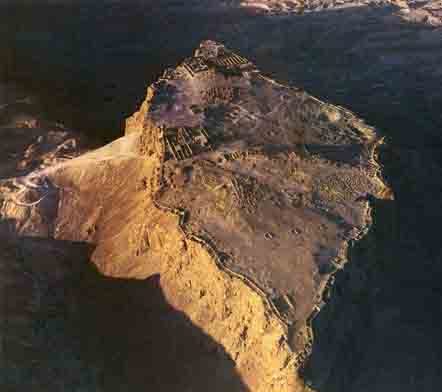
The last stand in the First Jewish Revolt against Rome took place on the nearly diamond-shaped mountaintop of Masada, site of a palace-fortress completed by Herod the Great (37–4 B.C.E.).
Jewish Zealots who occupied Masada at the start of the revolt in 66 C.E. held the site throughout the war and became the last outpost of resistance to the Romans after the fall of Jerusalem in 70 C.E. Despite a tenacious defense, the Zealots finally succumbed to the Roman siege in 73 or 74 C.E. Rather than allow themselves to be taken prisoner and enslaved, they chose to commit mass suicide.
Since Yigael Yadin’s untimely death in 1984, a group of scholarsa has been working assiduously to complete the final publication of Masada, Yadin’s most famous excavation. Herod’s desolate mountain palace-fortress at Masada is located in the Judean wilderness near the western shore of the Dead Sea.
Although Herod built palaces, baths, cisterns, storerooms and fortifications atop this extraordinary flat-topped, diamond-shaped mountain, the best-known chapter in Masada’s history is not Herod’s, but the Zealots’. The Zealots, a desperate band of Jews, occupied the site during the First Jewish Revolt against Rome, which, for all practical purposes, ended in 70 C.E.b when the Romans burned Jerusalem and destroyed the Temple.
At Masada, however, the Zealots held out for three or four years after Jerusalem fell. The relentless Roman army under Flavius Silva built eight siege camps around the site and constructed a gigantic ramp on the western side of the mountain as an entryway for their troops and as a platform for their battering rams and ballistae (missile-throwing machines).
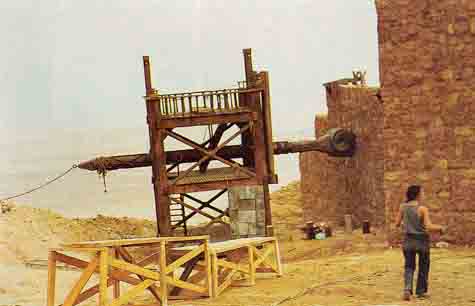
The Roman siege of Masada is described in great detail by the first-century Jewish historian Josephus. According to his account, when all was lost, the defenders committed mass suicide rather than surrender to the Romans. Each man killed his own family. Ten men were then selected to kill the rest. One of the ten was then selected by lot to kill the remaining nine. In the words of Josephus:
“[T]he nine bared their throats, and the last solitary survivor, after surveying the prostrate multitude, to see whether haply amid the shambles there were yet one left who needed his hand, and finding that all were slain, set the palace ablaze, and then collecting his strength drove his sword clean through his body and fell beside his family” (The Jewish War 7.397–398).
Yadin’s expedition found 11 potsherds, each inscribed with a different name, that may have been the lots cast to determine who would kill their comrades. One of the lots bore the name of Eleazar Ben Ya’ir, the Zealot leader.
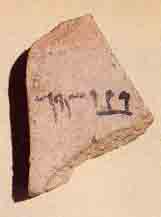
When the Romans finally burst into the fortress, they expected a battle, but they found only silence.c Food remaining in the storerooms demonstrated that the defenders had not been starved out.
According to Josephus, the Romans gained entry into the fortress by setting fire to a wood-reinforced earthen wall. The Zealots had built this wall inside the stone fortress wall at the point where the Roman siege ramp reached the outer wall. Josephus describes this additional wood-and-earth wall in some detail. It was built hastily, he tells us, and was intended to withstand attack from the Roman battering rams, “for it was pliable and calculated to break the force of the impact.” Here is Josephus’ description of the wall’s construction:
“Great [wooden] beams were laid lengthwise and contiguous and joined at the extremities; of these were two parallel rows a wall’s breadth apart, and the intermediate space was filled with earth. Further, to prevent the soil from dispersing as the mound rose, they clamped, by other transverse beams, those laid longitudinally. The work thus presented to the enemy the appearance of masonry [the original outer stone wall that surrounded the entire fortress], but the blows of the engines [battering rams] were weakened, battering upon a yielding material which, as it settled down under the concussion, merely served to solidify it” (The Jewish War 7.311–314).
The wood of this partly soil wall, however, unlike stone, was not fire-resistant, a fact, according to Josephus, that did not escape Silva, the Roman commander:
“Silva, thinking it easier to destroy this wall by fire, ordered his soldiers to hurl at it showers of burning torches. Being mainly made of wood, it quickly caught fire, and, from its hollow nature becoming ignited right through and blazed up in a volume of flame” (The Jewish War 7.315–316).
Yadin’s extensive excavation of Masada between 1963 and 1965 uncovered no direct evidence of this wood-and-earth wall. The section of the wall located directly in front of the Roman ramp had been greatly destroyed, but no evidence of a conflagration or of an unusual amount of earth was uncovered. On the other hand, some of this area (including an outer structure—tower 1010) was not excavated because of interference from the service-cablecar constructed when the excavation was started. (It is still in use today.)
The question naturally arises as to whether this wood-and-earth wall was an invention of Josephus—or possibly of his sources. Another question: How could the desperate Zealots, in the midst of the Judean wilderness and surrounded by the Romans, suddenly have found all the wooden beams necessary to construct and support this wall?
As I was studying this question, I noticed another anomaly. Only about ten percent of the buildings on Masada showed signs of having been burnt. Yet, according to Josephus, the last male survivor had set fire to the place before taking his own life.
Stranger still, the ten percent that had been consumed by fire was not contiguous. In other words, rooms here and there had been burnt, but for the most part they were not adjacent to one another. One would have thought that the fire lit by the last survivor would have spread from room to room. How could we account for the fact that rooms destroyed by fire seemed, instead, to dot the plan of the site?
There is no doubt that the idea of an inner wall, largely made of wood and earth, just inside the fortress wall at the top of the Roman ramp was a brilliant idea. The wall that surrounded the fortress was a stone casemate wall, consisting of two parallel walls broken at intervals by transverse walls between the two parallel walls, thereby creating casemates, or rooms. The outermost wall of the casemate was 5 feet thick; the innermost was 3 feet thick. This wall was no match for the Roman battering rams.
As the Roman ramp rose higher and the siege tower and battering rams came ever closer to the mountaintop, the siege reached a critical point. Other than escape or surrender, the Zealots had only one option: to prevent the breaching of the wall by strengthening it and possibly raising it higher, thereby making it more difficult for the battering rams to break through. Of course it could have been strengthened and heightened with stones, which were freely available (buildings could have been dismantled for this purpose). However, this would have been a difficult and prolonged process. The buildings on Masada were built with stones hewn from dolomite rock; they were hard and heavy, a fact that would have made their transfer to the probable point of breaching very difficult and would have made lifting the stones especially taxing. Moreover, if the Romans were able to remove even a few stones from the base, an entire section of the weakened wall could be knocked down.
Wood-reinforced earthen walls were common in Roman military construction. For Masada’s defenders, such a wall would be much easier and quicker to construct, and even if the Roman battering rams succeeded in displacing some beams, there would be no danger of the entire wall collapsing.
But where to get the wooden beams necessary for such a wall?
The likely answer was quite simple: Wooden beams were used in the roofs of all the rooms, halls and storerooms of Masada (with perhaps one or two exceptions). Most of these structures were built during the time of Herod. The desperate defenders could remove wooden beams from the buildings as well as from the casemate wall and towers that surrounded them. The great amounts of soil required to fill the wall, as Josephus reported, could be carried to the site from elsewhere on the mountaintop, even by women, children and the elderly.
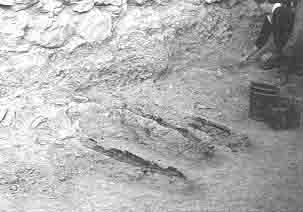
From the evidence of unburnt beams in two towers and the remains of burnt beams elsewhere, we know that the wooden ceiling beams most prevalent on Masada were about 13 to 16 feet long and 8 to 10 inches in diameter. There were also longer beams. Our calculations show that the Zealots must have dismantled more than 90 percent of the ceilings that were on the mountain. We estimate that they used about 4,000 13-foot-long beams, several dozen longer beams and hundreds of short beams (about 7 to 8 feet long). Working in haste and with many improvisations, here is how the Zealots may have constructed the wooden and earthen wall. The restoration we propose is but one of many possible forms of the wall.
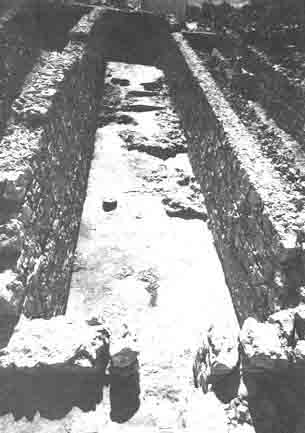
The new wall would reinforce the section of stone casemate wall that faced the top of the ramp constructed by the Romans outside the wall. The ramp’s purpose was to raise the Roman siege engines to the height where they could batter and breach the stone fortress wall. It is difficult to determine the exact location of the new wall and how tower 1010, located in that sector, was incorporated into it; however, we assume the tower was incorporated into the wall. It is also unclear how the newer wall related structurally to the existing casemate wall. It seems most likely to us that the inner wall of the casemate, as well as the roof that spanned the inner and outer walls, was dismantled.
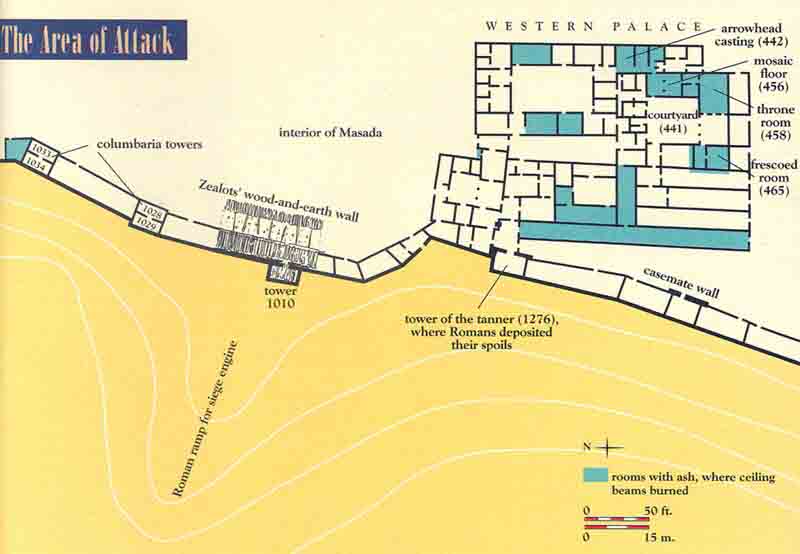
Against the original outer stone wall, on the inside of the fortress, a wood-and-earth wall was constructed, probably consisting of three parts: two stacks of wooden beams—each stack held together with ropes and nails—separated by an earth fill. The outermost stack, next to the remaining casemate wall, contained the 13- to 16-foot-long wooden beams scavenged from ceilings on the mountaintop. These beams were laid perpendicular to the outer stone wall with their ends butting against it. Mortar filled the spaces between the beams. This stack of beams probably extended about 6 to 10 feet higher than the original stone wall.
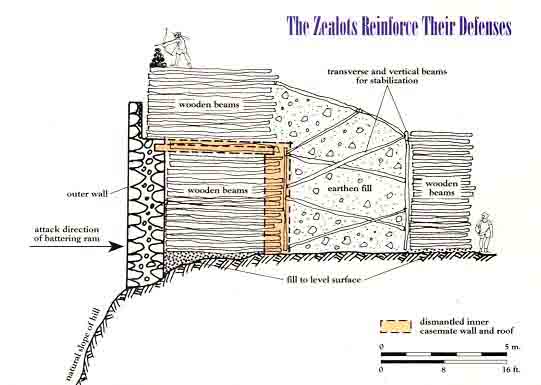
Approximately 12 feet from the outer wood-beam wall, an inner wood-beam wall was built. For this inner wall, Masada’s defenders probably used the shorter 7- to 8-foot-long beams, some of which were cut from the longer beams. Between the two stacks of beams, earth was packed. According to Josephus, this earth layer was as wide as “the wall’s thickness” (about 8 feet). The earth layer may have contained medium- and small-sized stones to help stabilize it. Josephus, in describing the earth-and-wood wall, mentions perpendicular beams (called warp beams, as opposed to weft beams, in some translations). We assume that he was speaking about long vertical beams in the earth layer that helped stabilize the soil, especially at the edges of the wall, so that it would not spill to the sides. It is also possible that an additional column of vertical beams separated the outer stack of horizontal beams from the layer of earth. These vertical beams would have helped spread the pressure of the battering rams over a wider area of the wall, hence diminishing the effect of their blows. According to our calculations of the amount of wood available, it would have been possible to build a wall 70 to 80 feet long, about 60 feet wide and 24 to 27 feet high, that is, a wall 4 to 8 feet higher than the original stone casemate wall. The new wall would have been practically impregnable to the battering machines, whereas the original stone wall could be shaken and damaged by battering its base. By increasing the height of the wall, the Zealots forced the Romans to raise the height of the siege ramp as well. Facing a stone wall, the Romans needed only to build their ramp to reach its base; but facing the new wall of wood and earth, which could not be easily undermined, the Romans had to build their ramp much higher; the new wall was vulnerable only from a higher position. This required the Romans to widen the base of the ramp by pouring additional earth and stones, a time-consuming task that postponed the attempt to breach the wall by weeks. Certainly this delay was needed by the besieged Zealots.
Impregnable as the new wood-and-earth wall was to battering, it was not invulnerable to fire. The Jewish defenders must have considered the possibility that the Romans would try to use fire to destroy the new wall they had built. Perhaps they even planned to prevent this, by covering the wooden beams with damp leather or by placing layers of mortar between the wooden beams at intervals to prevent the fire from spreading. It seems that they believed—that by one means or the other—they could prevent the wall from burning.
When we look at the evidence on the ground, do we find confirmation for our theory? Are there signs of the Zealots’ frantic last days spent dismantling wooden ceilings and of the fires that scorched the mountaintop structures before the Romans finally overcame the small band of Jewish defenders? The signs are everywhere.
Rooms, halls, corridors and storerooms with clear indications of fire are frequently seen side by side with those in which no signs of fire are to be found. We are certain that if all the wooden ceilings at Masada had been intact, fire would have spread easily and rapidly from room to room, destroying entire blocks—not single rooms or groups of rooms at random, as actually did happen.
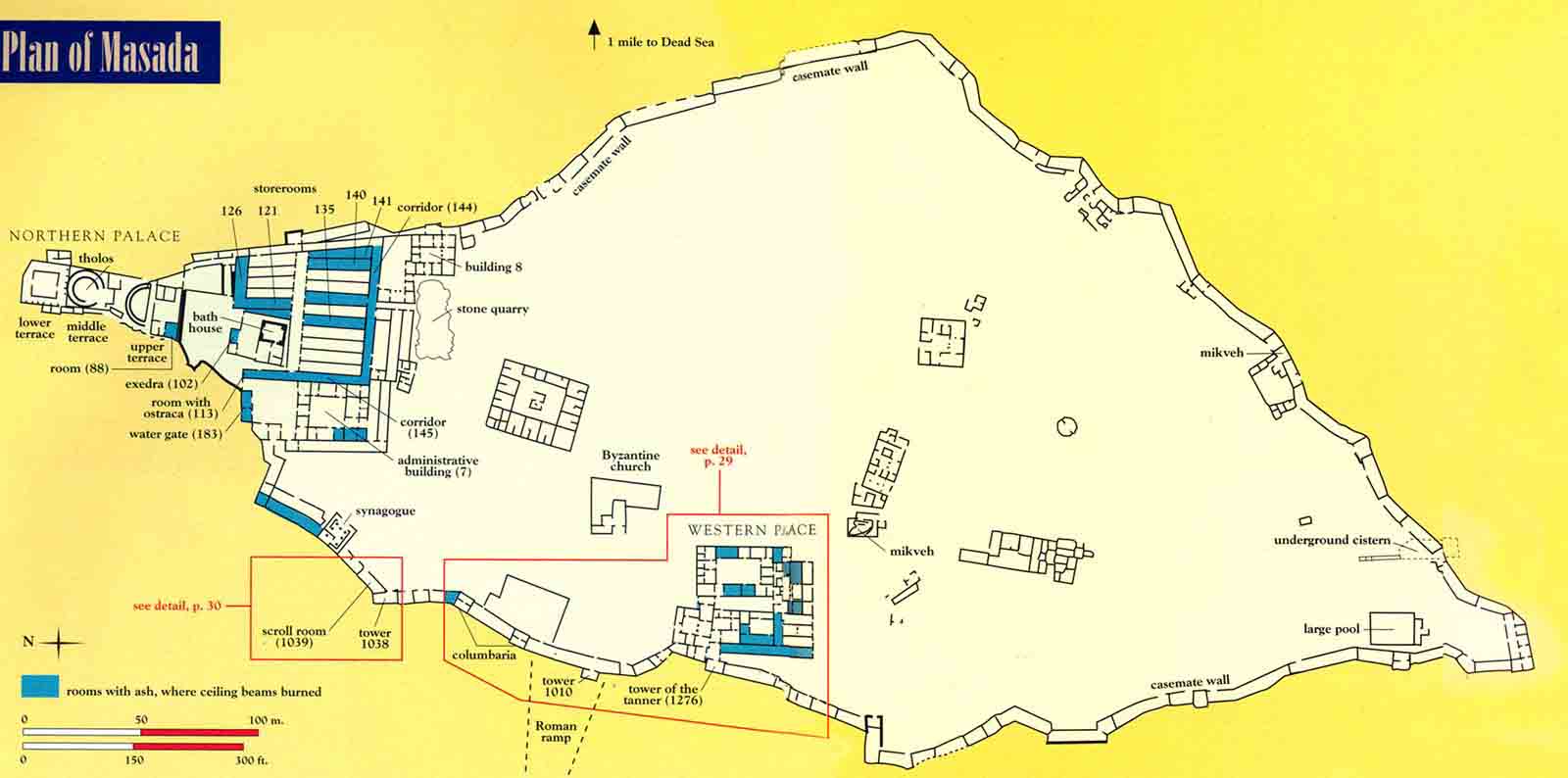
The selective dismantling of wooden ceiling beams seems to have begun in two large groups of buildings on Masada—the western and the northern palace areas. Both areas were located near the endangered wall sector opposite the Roman ramp, and both had many storerooms that must have been empty at the time. We assume that these palace areas were under communal supervision and, therefore, it was easier to carry out the decision to dismantle the ceilings in these buildings than in private residences.
The northern zone contained the palace built by Herod on three rock terraces, his elaborate bathhouse, the large complex of storerooms and a few other edifices. The Zealots, like Herod, administered this area as a closed and protected unit. The western palace, too, was used by the Zealots as a communal area. It was the only residential building not divided by the Zealots into secondary units. It contained central, large-scale kitchen facilities and a spacious storage area where storage jars as well as domestic utensils such as jugs and plates were found. Clearly, the dwelling area of the western palace was too large for one family. We believe that it was the residence of a group, living together in a collective life-style.
When the Zealots took over Masada during the revolt against Rome they found storerooms full of supplies. During their seven years of residence on the mountain, they slowly emptied the storerooms. At first sight, it would seem that these empty storerooms would have then served as living quarters. However, since they lacked sufficient light and air, most of them were unsuitable for this purpose.
We looked closely at the pattern of destruction by fire, assuming that the presence of ash meant wooden ceilings had been in place when Masada was torched; no ash meant that the ceilings had been previously removed. We found no signs of ash in most of the rooms and storerooms of the western palace. However, at the heart of the palace, around the courtyard (441), several luxurious rooms—the throne-room (458), a room with a splendid mosaic floor (456) and a frescoed room (465)—showed clear signs of the blaze that consumed their wooden ceilings.
Did the Zealots refrain from dismantling these ceilings so as to use the rooms as sleeping quarters, or out of a reluctance to destroy such magnificent rooms? Neither explanation seems correct. The objects uncovered in the mosaic room (456) suggest the reason this room was preserved; here was poignant evidence of the defense preparations that engaged the band of Zealots during their last fateful days. Iron arrowheads were strewn on this floor and that of room 442 to its east. These two rooms had become workshops for casting arrowheads.
In the northern palace zone the pattern of the conflagration is quite clear, even though some of the storerooms have not yet been excavated. The northern zone consisted of the rooms and terraces of the dramatic three-tiered palace that cascaded down the “prow” of the boat-shaped mountain; a large Roman-style bathhouse south of the palace; 18 storerooms, from 65 to 85 feet long, ranged in parallel rows to the east and south of the bathhouse; and a western building (building 7) constructed around a central courtyard.
Several of the long storerooms (140, 141, 135) in the northern palace area were found bums, with clay jars and pithoi in their ashy remains. Clear signs of conflagration were also evident in corridors surrounding the storerooms: on the south (144), on the west (113 and 145) and in the north, especially in the L-shaped corridor or storerooms (121 and 126). But in most of the excavated storerooms as well as in building 8 to the south of the storeroom area and building 7 to the west, the wooden ceilings must have been removed; no signs of burning were found.
In the northeastern block of the central storage rooms, beneath the northern end of the east corridor, a bathhouse was uncovered in great disarray, although without any sign of ashes. How had the extreme disorder occurred? We believe that the destruction at this site was not the result of the Roman garrisons seeking spoils (as Yadin assumed when he first exposed it), but rather resulted from the dismantling of the wooden ceilings of the bathhouse for use in the wood-and-earth wall.
Two small rooms, 183 and 184, to the west of the large bathhouse, were the scene of dramatic events during Masada’s last days. Room 183 is known as the water gate because it opened onto the footpath that descended to eight huge water cisterns on the northwestern slope of the mountain. Just to the east of the water gate was a long room (113) running north-south. In this long room Yadin found the 11 ostraca, inscribed potsherds, that he identified as the lots cast by Masada’s leaders to determine who would be the last to commit suicide before the Romans breached the walls. Great quantities of burnt ceiling debris as well as other ostraca were also found dumped into the northern section of room 113. How can we explain this?
Here is what we now think happened. After the fires set by the Zealots abated, Roman soldiers climbed the mountain by the access road that led from the huge cisterns on the flank of the hill. They entered the water gate and found the room filled with burned wood debris from its fallen ceiling. The same scene greeted the soldiers in the adjacent room 184. Expecting a battle with the entrenched Jews, the Roman soldiers rushed to ease their access onto the mountaintop by clearing away the still smoldering, charred wood. We now think that they dumped the debris into nearby room 113, carrying along with the ashy wood the 11 clay ostraca that would one day connect us to the men and events of 2,000 years ago.
In the great bathhouse in the center of the northern zone of the mountain, the signs of burning were confused, probably because the Roman soldiers emptied the building after their conquest of Masada. The only definite indication of conflagration was found in the exedra (102), a rectangular recess on the northern side of the bathhouse.
On the other hand, in the northern palace the picture is quite clear. Most of the ceilings of the lower terrace were dismantled before the fire, so we found no ash. On the middle terrace, signs of conflagration were evident in the group of rooms (most likely two-story structures) attached to the northern cliff of Masada. The main feature of this terrace—the tholos, or circular building surrounded by a colonnade—was probably dismantled by the Zealots in toto several years earlier, during their initial period of settlement on the mountain. The upper terrace of the northern palace also suffered from clearance operations, probably by the Romans in search of treasure, or possibly later, in the fifth or sixth century C.E., by Byzantine monks who occupied the mountain. Only the southwestern corner room (88) of the upper terrace presented indisputable evidence of fire.
The pattern persists as we look at all the excavated structures on Masada: a room here, a room there show telltale ash from wooden ceilings that were intact when Masada was set fire by the Jews. But most of the rooms in the buildings and within the casemate walls contained no ash; their wooden ceilings had been removed for use in the wall thrown up to resist the Roman battering rams.
With this understanding in mind, we can better understand what may have occurred in the Scroll Room (room 1039, in the casemate). Here Yadin discovered fragments of scrolls, papyri, silver shekel coins minted by Jews and dated to the second year of the revolt against Rome (67 C.E.) and many other artifacts. Beneath these precious articles he also found hundreds of stones. On top were smaller, 5-inch-diameter, catapult stones carved from soft limestone. Below were the large rolling stones, made from harder local dolomite, each one about 1.5 feet in diameter.
Adjacent to the Scroll Room was a tower (1038), also built into the casemate wall. Most probably, the Zealots placed a firing-machine (ballista) on top of the tower to hurl stones at the Roman soldiers building the ramp. As the need for wood became critical, the ceilings of the Scroll Room, of three small rooms (1050, 1051 and 1052) beside the Scroll Room and, finally, of tower 1038 were taken apart and reused in the defensive wall. The ballista stones piled on the roofs of the tower and the casemate wall fell into, or were thrown into, these rooms when the roofs were dismantled. When the Jewish resistance ended, the Romans came onto the mountain, gathered the spoils of documents and coins and threw them on top of the mound of stones—a silent reminder of the futile defense of the mountain fortress.
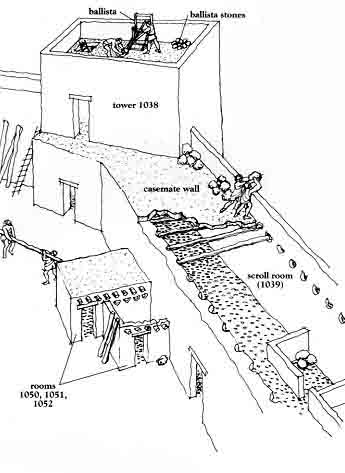
The fate of two special structures at Masada differed from everything else we found. These towerlike structures, called columbaria, contained small niches that probably sheltered pigeons. The square tower (1033–1034) in the western wall and the round tower (725) at the center of the southern part of the mountaintop showed no sign of fire, yet many of the original wooden beams were unearthed among the ruins exposed on the towers’ floors. It seems that the Zealots as well as the conquering Roman army chose to leave the columbaria intact, perhaps in order not to disturb the pigeons. We assume that another columbaria tower (1028–1029), also located in the western wall, was also left intact. This tower was cleared out and rebuilt later by the Byzantine monks, however, obscuring what happened at the time of the Jewish revolt.
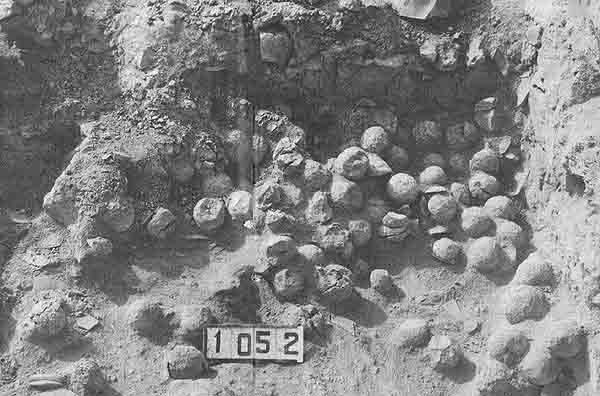
Our conclusion that hardly a single wooden ceiling remained intact on the eve of Masada’s destruction is indirectly supported by the location of Roman garrisons on the mountain after the destruction. The soldiers improvised temporary constructions, apparently covered with canvas, within building ruins or between them. If the Roman troops had found many roofed buildings, they would have used them for living quarters. But we found that only in very rare cases was this actually done, for example, in several rooms in the northern part of building 7. Roman coins and installations different from those built by the Zealots signaled use of these rooms by Roman soldiers. Even here, it may well be that the rooms were roofless and that the troops had to spread canvas sheets overhead.
Some people have tentatively proposed that the Roman troops looted the missing wooden ceiling beams after the destruction. It seems unlikely to us that they would have looted beams from structures in which they might have lived, only to use those beams to build other places to live. But still more difficult to answer is the question: How would wooden beams have survived the fires that burned over large areas of Masada after the Zealots’ death?
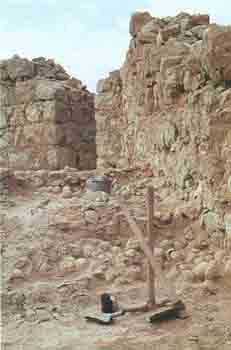
During Masada’s last days the entire Zealot community was engaged in dismantling the wooden ceilings and constructing the wood-and-earth wall. As the Romans built their ramp higher and higher, ever closer to the wall they sought to breach, the Zealots worked in frantic haste. They removed layers of clay soil, branches and reeds from above the ceiling beams, extracted the beams from the walls and transferred them to the construction site. Some beams were cut; nails and ropes were gathered. To avoid the catapult stones that rained on them during the day, the Zealots probably constructed their new wall at night. Working under these conditions, we calculate that it may have taken one to two weeks to build the new wall.
But despite the Zealots’ hopes and expectations, the wood-and-earth wall did not survive the test of fire. Josephus wrote that as soon as the wall was set on fire and the fire spread with the assistance of winds, the Zealots knew that nothing could prevent the Romans from breaking through to the mountaintop. In the face of their inevitable defeat, they decided not to be taken alive by the Romans, but to leave the Romans only scorched earth.
That the Jewish defenders succeeded in burning almost everything the Romans might have used is evident from the hearths that served as pyres for valuables. Furniture, personal items and things of value fueled the fires on these hearths and left their remains in the ash. However, in the haste of the Zealots last days and especially their last night, some spoils fell into the hands of the plunderers. We have already noted the finds in the Scroll Room; in another location, in the tower of the tanner (room 1276) in the casemate wall west of the western palace, scrolls, papyri and silver shekel coins were also discovered—probably gathered and abandoned there by the Romans.
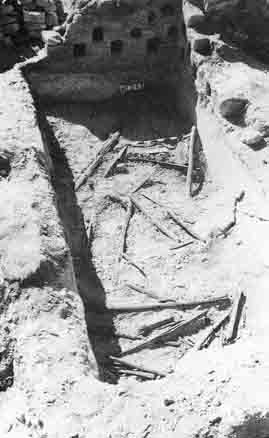
Where are the signs of the wood-and-earth wall that the Zealots threw up to face the Roman ramp? During Yadin’s expedition in the 1960s, he excavated the area of the wall almost completely down to bedrock. Not anticipating the Zealots’ defense wall, Yadin may have erased the subtle signs of its presence.
But there are several reasons why, even if he had been looking, Yadin might not have found anything there: The area is exposed to strong winds that would have blown away ashy remains and the earthen part of the structure. Fires in open places, rather than within the walls of rooms, leave little trace. Before the first course of long logs were laid in the wall, it was probably necessary to level the uneven bedrock by adding a layer of soil. The soil would have prevented the burning logs from leaving their charred imprints on the bedrock. Finally, the Byzantine monks may have removed the wall’s remains to use in their own construction just a few dozen feet to the north.
Although direct evidence of the wood-and-earth wall is absent, there is no doubt that the Roman soldiers entered Masada at the point in front of the siege ramp. No other section of Masada’s wall suffered so much damage. The huge fire set by Roman torches that blazed in the night at the western edge of Masada ended any hope the Jews may have held that somehow they could survive the Roman attack.
The destruction of Herod’s palaces, storerooms and bathhouses on Masada began with their dismantling by the Zealots and with the fire they later set to consume everything that remained. After the Roman attackers were long gone, Masada’s decay continued slowly in the years that followed. Wind and rain eroded the structures that remained and, in the first centuries C.E., one or more earthquakes caused major damage. By the fifth or sixth century, when Byzantine monks reached the top of Masada, they found mound upon mound of ruins—a sight not unlike the one we found when Yadin began the excavations on Masada.
MLA Citation
Footnotes
The scholars involved in this project, and their areas of responsibility, are Gideon Foerster and Ehud Netzer, coordinators, Ehud Netzer, description of the site and architecture; Gideon Foerster architectural elements and background; Joseph Naveh, Hebrew and Aramaic ostraca; Ya’akov Meshorer, coins; Hanna M. Cotton and Joseph Geiger, Latin and Greek documents; Rachel Bar Natan, ceramics; Dan Barag and Malka Hershkoviz, lamps; Avigdal Sheffer, textiles; Shemaryahu Talmon, scrolls.
B.C.E. (Before the Common Era) and C.E. (Common Era), used by this author, are the alternate designations corresponding to B.C. and A.D. often used in scholarly literature.
Although, theoretically, Josephus may have joined the Roman army during the siege, there is no data. However, I believe that there is a basis for his testimony that “an old woman and another, a relative of Eleazar, superior in sagacity and training to most of her sex, with five children, escaped by concealing themselves in the subterranean aqueducts, while the rest were absorbed in the slaughter” (The Jewish War 7.399), which could describe what happened.
